Brian Ellis
Meta Audiobox Aesthetics: Unified Automatic Quality Assessment for Speech, Music, and Sound
Feb 07, 2025



Abstract:The quantification of audio aesthetics remains a complex challenge in audio processing, primarily due to its subjective nature, which is influenced by human perception and cultural context. Traditional methods often depend on human listeners for evaluation, leading to inconsistencies and high resource demands. This paper addresses the growing need for automated systems capable of predicting audio aesthetics without human intervention. Such systems are crucial for applications like data filtering, pseudo-labeling large datasets, and evaluating generative audio models, especially as these models become more sophisticated. In this work, we introduce a novel approach to audio aesthetic evaluation by proposing new annotation guidelines that decompose human listening perspectives into four distinct axes. We develop and train no-reference, per-item prediction models that offer a more nuanced assessment of audio quality. Our models are evaluated against human mean opinion scores (MOS) and existing methods, demonstrating comparable or superior performance. This research not only advances the field of audio aesthetics but also provides open-source models and datasets to facilitate future work and benchmarking. We release our code and pre-trained model at: https://github.com/facebookresearch/audiobox-aesthetics
High Fidelity Text-Guided Music Generation and Editing via Single-Stage Flow Matching
Jul 04, 2024



Abstract:We introduce a simple and efficient text-controllable high-fidelity music generation and editing model. It operates on sequences of continuous latent representations from a low frame rate 48 kHz stereo variational auto encoder codec that eliminates the information loss drawback of discrete representations. Based on a diffusion transformer architecture trained on a flow-matching objective the model can generate and edit diverse high quality stereo samples of variable duration, with simple text descriptions. We also explore a new regularized latent inversion method for zero-shot test-time text-guided editing and demonstrate its superior performance over naive denoising diffusion implicit model (DDIM) inversion for variety of music editing prompts. Evaluations are conducted on both objective and subjective metrics and demonstrate that the proposed model is not only competitive to the evaluated baselines on a standard text-to-music benchmark - quality and efficiency-wise - but also outperforms previous state of the art for music editing when combined with our proposed latent inversion. Samples are available at https://melodyflow.github.io.
Audiobox: Unified Audio Generation with Natural Language Prompts
Dec 25, 2023Abstract:Audio is an essential part of our life, but creating it often requires expertise and is time-consuming. Research communities have made great progress over the past year advancing the performance of large scale audio generative models for a single modality (speech, sound, or music) through adopting more powerful generative models and scaling data. However, these models lack controllability in several aspects: speech generation models cannot synthesize novel styles based on text description and are limited on domain coverage such as outdoor environments; sound generation models only provide coarse-grained control based on descriptions like "a person speaking" and would only generate mumbling human voices. This paper presents Audiobox, a unified model based on flow-matching that is capable of generating various audio modalities. We design description-based and example-based prompting to enhance controllability and unify speech and sound generation paradigms. We allow transcript, vocal, and other audio styles to be controlled independently when generating speech. To improve model generalization with limited labels, we adapt a self-supervised infilling objective to pre-train on large quantities of unlabeled audio. Audiobox sets new benchmarks on speech and sound generation (0.745 similarity on Librispeech for zero-shot TTS; 0.77 FAD on AudioCaps for text-to-sound) and unlocks new methods for generating audio with novel vocal and acoustic styles. We further integrate Bespoke Solvers, which speeds up generation by over 25 times compared to the default ODE solver for flow-matching, without loss of performance on several tasks. Our demo is available at https://audiobox.metademolab.com/
Seamless: Multilingual Expressive and Streaming Speech Translation
Dec 08, 2023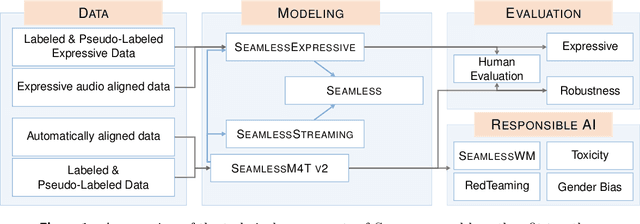
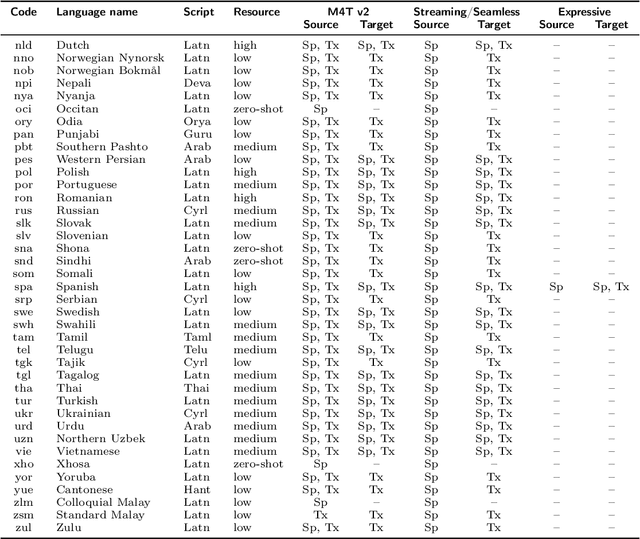

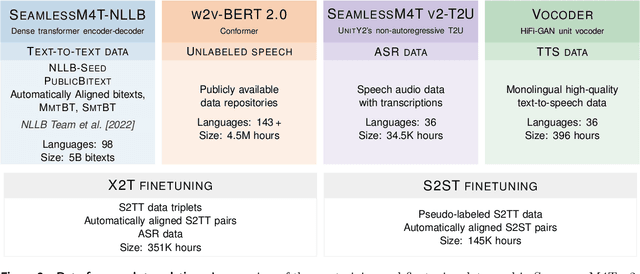
Abstract:Large-scale automatic speech translation systems today lack key features that help machine-mediated communication feel seamless when compared to human-to-human dialogue. In this work, we introduce a family of models that enable end-to-end expressive and multilingual translations in a streaming fashion. First, we contribute an improved version of the massively multilingual and multimodal SeamlessM4T model-SeamlessM4T v2. This newer model, incorporating an updated UnitY2 framework, was trained on more low-resource language data. SeamlessM4T v2 provides the foundation on which our next two models are initiated. SeamlessExpressive enables translation that preserves vocal styles and prosody. Compared to previous efforts in expressive speech research, our work addresses certain underexplored aspects of prosody, such as speech rate and pauses, while also preserving the style of one's voice. As for SeamlessStreaming, our model leverages the Efficient Monotonic Multihead Attention mechanism to generate low-latency target translations without waiting for complete source utterances. As the first of its kind, SeamlessStreaming enables simultaneous speech-to-speech/text translation for multiple source and target languages. To ensure that our models can be used safely and responsibly, we implemented the first known red-teaming effort for multimodal machine translation, a system for the detection and mitigation of added toxicity, a systematic evaluation of gender bias, and an inaudible localized watermarking mechanism designed to dampen the impact of deepfakes. Consequently, we bring major components from SeamlessExpressive and SeamlessStreaming together to form Seamless, the first publicly available system that unlocks expressive cross-lingual communication in real-time. The contributions to this work are publicly released and accessible at https://github.com/facebookresearch/seamless_communication
SeamlessM4T-Massively Multilingual & Multimodal Machine Translation
Aug 23, 2023
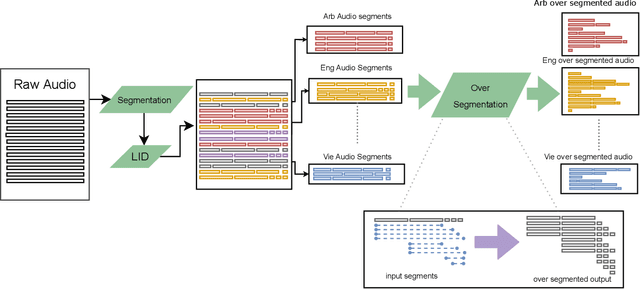
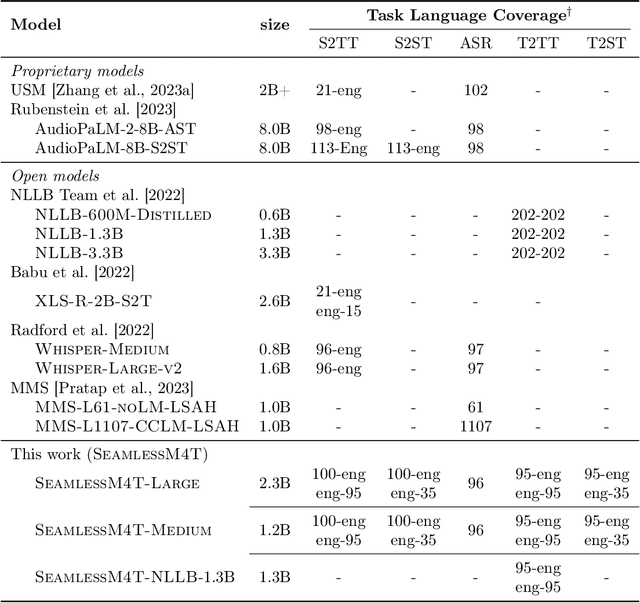
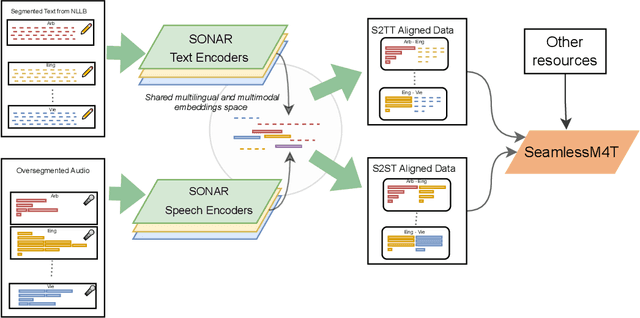
Abstract:What does it take to create the Babel Fish, a tool that can help individuals translate speech between any two languages? While recent breakthroughs in text-based models have pushed machine translation coverage beyond 200 languages, unified speech-to-speech translation models have yet to achieve similar strides. More specifically, conventional speech-to-speech translation systems rely on cascaded systems that perform translation progressively, putting high-performing unified systems out of reach. To address these gaps, we introduce SeamlessM4T, a single model that supports speech-to-speech translation, speech-to-text translation, text-to-speech translation, text-to-text translation, and automatic speech recognition for up to 100 languages. To build this, we used 1 million hours of open speech audio data to learn self-supervised speech representations with w2v-BERT 2.0. Subsequently, we created a multimodal corpus of automatically aligned speech translations. Filtered and combined with human-labeled and pseudo-labeled data, we developed the first multilingual system capable of translating from and into English for both speech and text. On FLEURS, SeamlessM4T sets a new standard for translations into multiple target languages, achieving an improvement of 20% BLEU over the previous SOTA in direct speech-to-text translation. Compared to strong cascaded models, SeamlessM4T improves the quality of into-English translation by 1.3 BLEU points in speech-to-text and by 2.6 ASR-BLEU points in speech-to-speech. Tested for robustness, our system performs better against background noises and speaker variations in speech-to-text tasks compared to the current SOTA model. Critically, we evaluated SeamlessM4T on gender bias and added toxicity to assess translation safety. Finally, all contributions in this work are open-sourced and accessible at https://github.com/facebookresearch/seamless_communication
 Add to Chrome
Add to Chrome Add to Firefox
Add to Firefox Add to Edge
Add to Edge